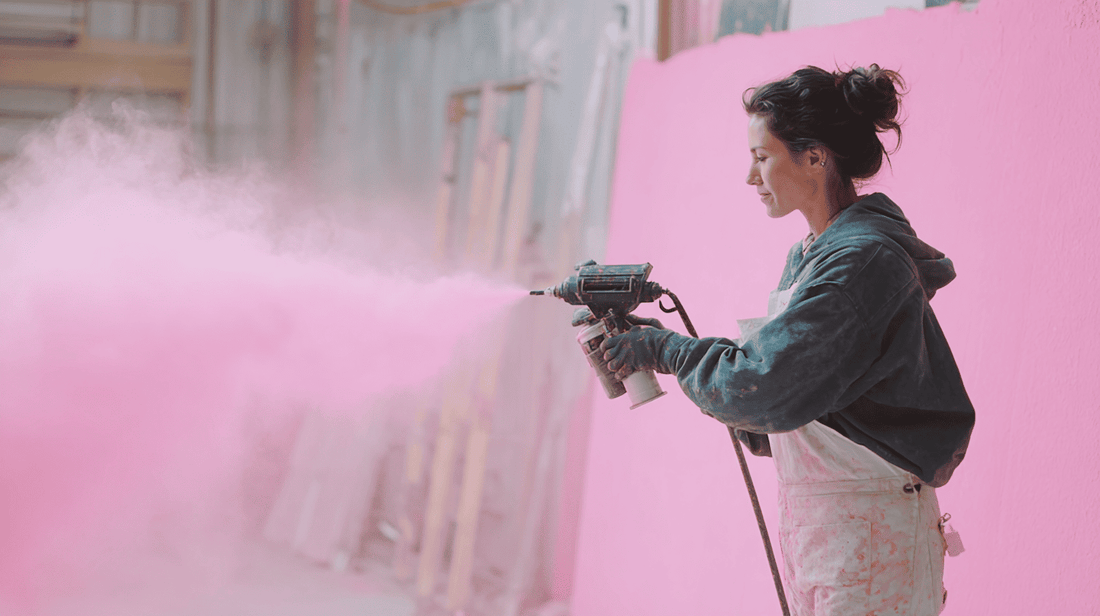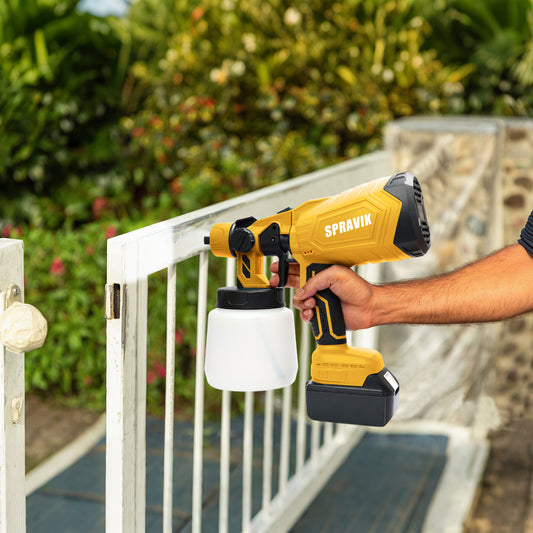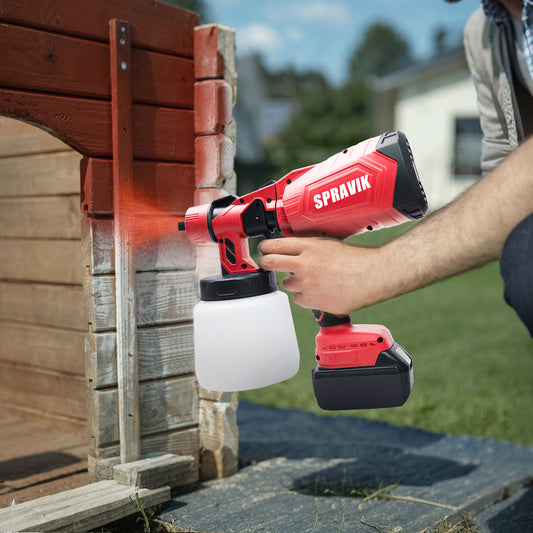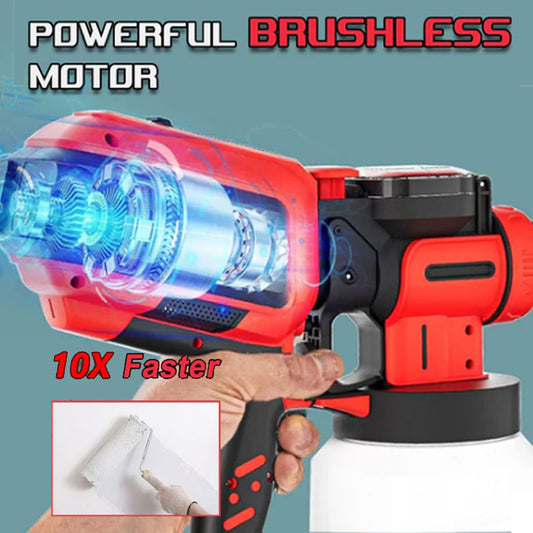
Paint Sprayer vs Traditional Painting Tools: Which Saves More Time & Money?
Spravik AdminShare
When it comes to painting, most people default to brushes and rollers. While these traditional tools have been used for decades, modern paint sprayers offer a faster, more efficient alternative. For homeowners, DIY enthusiasts, and professionals alike, choosing the right tool can save both time and money while delivering a higher-quality finish.
This guide explores paint sprayers vs traditional painting tools, comparing speed, cost, finish quality, and usability, so you can make an informed choice for your next project.
Why Consider a Paint Sprayer?
Keywords: paint sprayer vs roller, spray gun benefits, DIY paint sprayer
Speed: Paint sprayers can cover walls, ceilings, furniture, and fences much faster than brushes or rollers.
Professional Finish: Even beginners can achieve smooth, streak-free coats.
Versatility: Sprayers work on almost any surface—walls, doors, cabinets, furniture, decks, and fences.
Less Fatigue: No repetitive brushing or rolling motion for hours on end.
Comparing Paint Sprayers and Traditional Tools
| Feature | Paint Sprayer | Brushes & Rollers |
|---|---|---|
| Coverage Speed | High – finishes large areas quickly | Moderate – time-consuming for large surfaces |
| Finish Quality | Smooth, even, professional | Can show brush strokes or roller marks |
| Ease of Use | Requires initial learning | Intuitive, but slow |
| Paint Usage | Efficient with proper technique | Slightly more paint required for even coverage |
| Prep & Cleanup | Moderate – cleaning required, but fast with quick-clean systems | Easy – brushes can be washed, rollers take longer |
| Cost | Sprayer upfront cost higher, saves labor | Low upfront cost, higher labor/time costs |
| Versatility | Works on walls, furniture, fences, cabinets, ceilings | Limited – brushes/rollers better for small detail |
Time Savings
Keywords: paint sprayer efficiency, fast painting, DIY paint time
Large Projects: Sprayers reduce hours of labor. Painting a full room or outdoor fence can take 2–3x less time than using rollers or brushes.
Furniture and Cabinets: HVLP sprayers deliver smooth, thin coats quickly, compared to meticulous brushwork.
Multiple Coats: Sprayers allow thin, even layers, reducing the need for sanding between coats.
💡 Pro tip: Even a few hours saved per project adds up, making a sprayer a smart investment for frequent painters.
Cost Comparison
Keywords: paint sprayer cost vs roller, ROI spray gun
Upfront Costs:
Paint sprayer: Higher initial investment, typically $100–$400+ depending on type.
Brushes/Rollers: Very low cost, $5–$30 for a complete set.
Labor Costs:
Time saved with a sprayer translates to lower labor costs for professionals.
For DIYers, it reduces fatigue and allows finishing projects faster, freeing time for other tasks.
Paint Efficiency:
Sprayers can use less paint with proper technique due to even coverage.
Rollers often absorb excess paint and require multiple coats.
📌 Conclusion: Over multiple projects, a sprayer often pays for itself in saved time and paint.
Finish Quality
Keywords: smooth paint finish, professional spray finish
Sprayers: Deliver streak-free, smooth coats. Ideal for furniture, cabinets, and decorative projects.
Brushes: Good for corners and trim but may leave brush marks.
Rollers: Cover large walls quickly but can leave subtle texture.
💡 Pro tip: For a professional look on any surface, a paint sprayer is the superior choice.
Usability and Learning Curve
Brushes/Rollers: Very beginner-friendly, but slow.
Paint Sprayers: Require practice to master distance, speed, and overlapping technique.
Solution: Start with scrap material to gain confidence. Spravik sprayers are designed for easy learning, lightweight handling, and adjustable nozzles for consistent results.
Best Projects for Each Tool
Paint Sprayer
Walls and ceilings (large coverage)
Fences and decks (outdoor projects)
Cabinets, furniture, and doors (smooth finish)
Creative DIY projects (decor, planters, frames)
Brushes & Rollers
Small touch-ups or corners
Detailed trim work
Spot painting or textured walls
Tips to Maximize Sprayer Efficiency
Keywords: paint sprayer tips, efficient spray painting
1.Prep Surfaces Thoroughly: Clean, sand, and mask for best adhesion.
2.Thin Paint if Needed: Follow sprayer guidelines for optimal spray patterns.
3.Multiple Thin Coats: Avoid drips and achieve uniform coverage.
4.Overlap Passes: Each stroke should overlap the previous 30–50% for even layers.
5.Clean Immediately After Use: Prevents clogs and extends sprayer lifespan.
💡 Pro tip: Cordless or electric Spravik paint sprayers make cleanup and setup faster than other brands.
Why Spravik Paint Sprayers Are Worth It
Speed: Cover large areas in a fraction of the time.
Professional Finish: HVLP, airless, and cordless sprayers give smooth results.
Ease of Use: Lightweight, ergonomic designs with adjustable spray patterns.
Durability: Built to last and handle repeated use without performance loss.
Versatility: Ideal for walls, furniture, fences, cabinets, and creative DIY projects.
Final Verdict
While traditional brushes and rollers remain useful for small details, paint sprayers clearly outperform in speed, finish quality, and efficiency. For anyone tackling multiple projects, large areas, or looking for professional results with minimal effort, a Spravik paint sprayer is the smarter investment.
Save Time: Reduce project duration by hours.
Save Money: Efficient paint use and reduced labor make up for the initial cost.
Get a Professional Finish: Smooth, streak-free results on every project.
Whether you are a DIY enthusiast or a professional, upgrading to a paint sprayer is the key to faster, cleaner, and more efficient painting.










